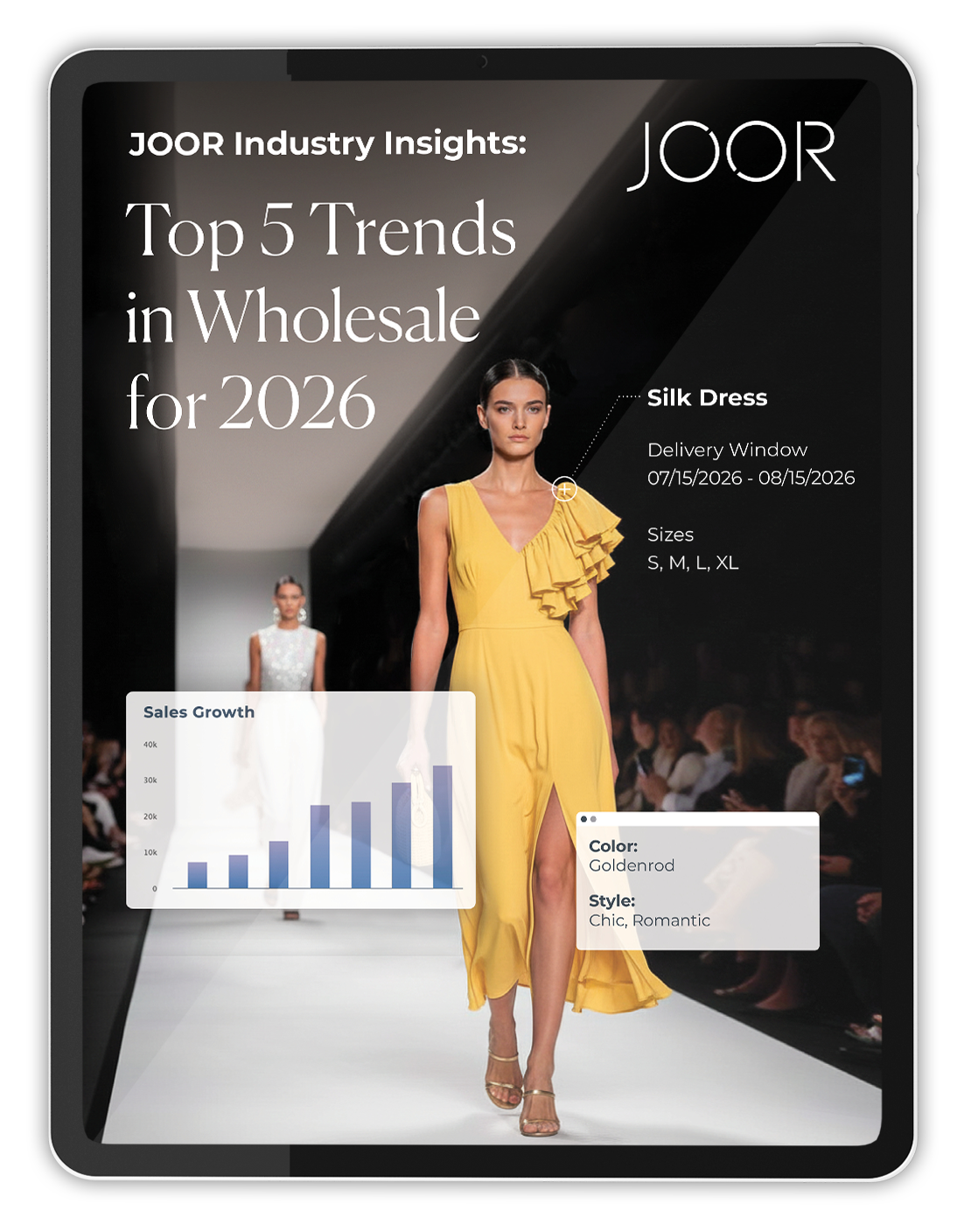Markup vs. Margin: A Guide for Wholesale Fashion Brands
Unlock profitability by understanding the difference between markup and margin. Learn to calculate and apply these strategies to optimize pricing and maximize profits in the wholesale fashion market.
%2520(4).avif)
Quick Summary: Understanding Markup vs. Margin in Wholesale Fashion
Many wholesale fashion brands lose profits by miscalculating markup and margin, or confusing the two entirely. This guide breaks down both pricing strategies with examples, formulas, and expert tips to help you boost your clothing profit margins.
Even though it's common for fashion brands to confuse markup and margin, knowing the difference is key to pricing your clothing line profitably. Markup tells you how much you add to your cost price, while margin shows what percentage of each sale is profit.
Here's how to calculate both:
- Markup (%) = (Selling Price - Cost) / Cost
- Margin (%) = (Selling Price - Cost) / Selling Price
Get this wrong, and you could set prices that look profitable but aren’t. Let’s dig into how to avoid those pitfalls.
What You’ll Learn About Markup vs. Margin in this Guide
Whether you're launching a new fashion brand or scaling your wholesale operation, understanding the difference between markup and margin is critical to profitability.
This guide will help you:
- Learn how to calculate markup and margin using proven formulas
- Avoid common pricing mistakes that erode profits
- Discover which metric matters most depending on your sales model
- Align your pricing strategy with retail partner expectations
Mastering these pricing fundamentals gives your brand the confidence to price smarter, grow faster, and stay competitive in today’s wholesale fashion landscape.
Is Your Pricing Strategy Costing You More Than You Think?

If you’re running a wholesale fashion brand, mis-pricing can quietly erode your profits, damage brand perception, and create friction with retail partners.
Ask yourself:
- Are you unsure whether your current pricing model is maximizing your wholesale profit margins?
- Do pricing, product bundling, and seasonal promos often confuse your margin calculations?
- Is your lack of pricing clarity affecting supplier negotiations or investor confidence?
- Are your prices mismatched with customer expectations, leading to weak sales or brand disconnect?
These challenges are especially common among emerging brands still building scale and operational efficiency. Without economies of scale, it’s easy to underprice just to compete, hurting your long-term margins.
That’s why understanding the difference between markup and margin isn’t optional. It’s a strategic foundation that helps you set smarter prices, safeguard your bottom line, and position your brand to grow profitably.
What is Markup in Wholesale Fashion?
In fashion wholesale, markup is the percentage you add to your product cost to set a profitable selling price. It's based on your cost, not the final sale price making it essential to get this calculation right.
How Markup Works Along the Supply Chain
- A manufacturer marks up the production cost before selling to you.
- You, as the wholesaler, then apply your markup when selling to retailers.
- Retailers add their own markup to reach the end-customer price.
Most wholesale fashion brands aim for a markup between 120% and 160%, depending on production costs, competition, and what retailers are willing to pay.
Knowing how to calculate and benchmark your markup helps ensure every item you sell is contributing positively to your bottom line.
How to Calculate Markup in Wholesale Fashion
To calculate markup, divide your profit by the cost of the item, then multiply by 100 to get a percentage:
Markup Formula:
Markup (%) = (Selling Price - Cost) / Cost × 100
Example:
- Cost Price = $30
- Selling Price = $70
- Markup = ($70 - $30) / $30 × 100 = 133.3%
This means you're charging 133.3% more than what the item cost you. In fashion wholesale, this helps ensure you're covering operational costs while hitting profitability targets.
Tip: Most fashion wholesalers apply a markup of 120–160%, depending on competition, scale, and retailer expectations.
What Is Margin in Fashion Wholesale?
Margin represents how much profit you keep from a sale, expressed as a percentage of the selling price. Unlike markup, which is based on your cost, margin starts from your revenue and looks backward to assess profitability.
Why It Matters:
- Helps you understand how much revenue is actual profit
- Essential for managing cash flow, setting targets, and impressing investors
- Key to evaluating the health of different product lines
How to Calculate Margin in Wholesale Fashion
Use this formula to calculate your margin:
Margin (%) = (Selling Price - Cost) ÷ Selling Price × 100
Example:
You buy a product for $30 and sell it for $70
- Profit = $40
- Margin (%) = ($40 ÷ $70) × 100 = 57.1%
Most fashion wholesalers aim for 50–60% margins, but that can vary based on scale, channel (DTC vs wholesale), and cost structure.
Understanding margin helps you identify how profitable each product is—helping you adjust pricing, cut costs, or improve product mix decisions.
Markup vs. Margin: Which Should Fashion Brands Use?
Both markup and margin have a role in fashion pricing but they serve different purposes depending on what you're trying to measure.
Example Recap:
- Markup on a $30 product sold at $70 = 133.3%
- Margin = 57.1% of the selling price
To Summarize:
Use markup when setting item-level prices.
Use margin when analyzing overall financial performance.
For growing wholesale brands, margin is generally a more reliable metric for long-term success. But knowing how to use both gives you a complete picture of your pricing and profitability.
What are the Consequences of Misunderstanding Markup vs. Margin?

Not understanding the difference between markup and margin can quietly undermine your entire pricing strategy.
For fashion brands, this often leads to:
- Overestimating profitability
- Misaligning price with product value
- Leaving little room for scale, promotions, or retail negotiations
Even small pricing missteps can make it difficult to grow sustainably or compete effectively. That’s where JOOR’s tools can help prevent profit leakage and support smarter decision-making.
1. Real-Time Inventory Visibility Prevents Margin Misfires
With JOOR, you get live stock insights, helping you avoid overstocking or understocking - both of which directly impact pricing and promotions. By tracking demand in real time, you can adjust markups to reflect current inventory and market conditions.
2. Marketplace Access Enables Better Supplier Margins
JOOR’s wholesale marketplace exposure gives you broader reach, helping drive sales volume. Higher order volume often leads to economies of scale, allowing you to negotiate better supplier costs and increase your markup potential.
3. Smarter Order Management Reduces Margin-Eroding Errors
Centralized and efficient b2b order management tools reduce costly errors, delays, and returns. This boosts profit margins and gives you more flexibility to optimize pricing or scale operations without hidden losses.
4. Actionable Analytics Drive Smarter Pricing Strategy
JOOR’s advanced wholesale reporting tools track buyer behavior, product performance, and sales trends. You can identify high-margin products and reprioritize your catalog to boost profitability across the board.
5. ERP & CRM Integration Enhances Forecasting Accuracy
Integrating JOOR with your ERP or CRM systems improves demand forecasting. This helps ensure that markup and pricing decisions are data-driven, scalable, and better aligned with your operational capacity.
Final Thoughts: Mastering Markup vs. Margin for Profitable Fashion Pricing

Mastering markup and margin is more than a numbers game - it’s a strategic move that empowers your brand to price competitively, protect profit margins, and scale confidently. When you understand how these calculations influence everything from production to retail pricing, you gain full control over your business growth.
Whether you're optimizing SKUs, negotiating supplier costs, or refining promotions knowing your markup and margin helps you lead with data, not guesswork.
Discover how a b2b ecommerce platform like JOOR helps fashion brands like yours:
- Set smart, competitive pricing
- Track and optimize margins in real time
- Eliminate manual errors from your sales process
- Build pricing strategies backed by data
Book a JOOR demo today to help protect your profits, and your vision.
Related Insights

Why Digital B2B Catalogs are Essential for E-Commerce Businesses
Online catalogs have become a crucial component for retailers and their buyers in an evermore tech reliant industry. Read about how these dynamic product libraries act as comprehensive selling solutions that plug into current buying behaviors.
%2520(2)%2520(1).avif)
8 Ways a B2B Fashion Marketplace Solves Wholesale Scaling Challenges
Learn how a B2B fashion marketplace like JOOR helps your wholesale fashion brand overcome scaling challenges. Maximize resources, build retailer relationships, and enhance distribution to drive growth in the global wholesale fashion market.
%2520(1).avif)
Price Sheets Vs Line Sheets in Wholesale Fashion
Explore the key differences between price sheets and line sheets in wholesale fashion. Optimize product showcasing and sales strategies with clear pricing details and captivating visuals. Enhance buyer experience and streamline ordering process effectively.


